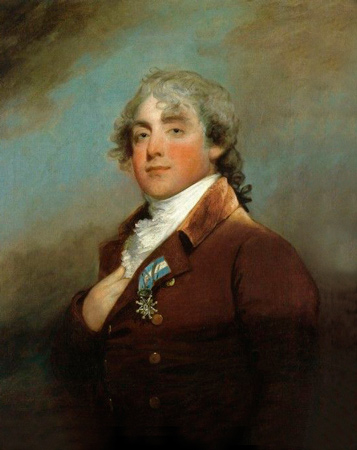In Washington City, the Spanish minister to the United States, Carlos Martínez de Yrujo, writes a letter to the Chief Minister of Spain with an update on the progress of President Jefferson’s proposal to send an expedition to the Pacific ocean—an act Spain opposes. The Senator from New York, Samuel Mitchell, debates Jefferson’s need to keep the expedition a secret.
The Marqués de Casa Irujo (1804)
by Gilbert Stuart (1755–1828)
Image in the public domain, from WikiCommons.
Casa Irujo (also spelled Yrujo) was the Spanish minister to the United States from 1796 to 1807. As described by Henry Adams, he was inextricably connected to the young United States yet fiercely loyal to Spain:
In Jefferson’s domestic as well as in his political household Don Carlos Martinez de Yrujo,—created in 1802 Marquis of Casa Yrujo,—the minister of Spain, was thoroughly at home, for he had a double title to confidence, and even to affection. His first claim was due to his marriage with a daughter of Governor McKean of Pennsylvania, whose importance in the Republican party was great. His second claim was political. . . . One of President Jefferson’s first diplomatic acts was to ask from the Spanish government that Yrujo should be allowed to remain at Washington . . . .[1]Henry Adams, History of the United States During the Administrations of Thomas Jefferson (New York: Literary Classics of the United States, Inc., 1986 reprint) 2:286.
Spanish Update
[31 January 1803]
I notified Your Excellency that the President of the United States had a project directed to send travelers in order to explore the course of the Missouri River, who Continuing their expedition up to the North West Coast, they were to examine the possibility or impossibility of communications by water, between the Atlantic Ocean and the Southern [Pacific] Ocean, and contribute to advance the geography of the North of America.
I also told Your Excellency the conversation which pertaining to this project, the President had with me concerning this plan, he desiring to know whether our Court would refuse to grant the necessary passports to the travelers, and all of which I judged opportune to reply to you concerning the particular. I thought that in consequence he would desist in his attempt . . . .
I have learned that he has communicated his design to the Senate, which has already taken a step towards the execution. Nevertheless I have understood that the good judgment of the Senate does not see the advantages that the President proposes in this expedition, and that on the contrary, they feared it might offend one of the European nations, and consequently it is very probable that the project will not proceed.
The Marqués de Casa Yrujo.[2]Carlos Martínez du Yrujo to Pedro Cevallos, Washington City in Before Lewis and Clark: Documents Illustrating the History of the Missouri 1785–1804, ed. A. P. Nasatir, Bison Books edition … Continue reading
Jefferson’s Secrecy Debated
My Dear Kate:
I write you from a secret conclave of Congress . . . the House of Representatives is now setting with closed doors. The Galleries were cleared a little while ago to receive a confidential communication. After receiving it, a Debate arose whether it ought to be considered as a secret any longer or whether the Injunction of Secrecy should be taken off. And that discussion is now going on. So I thought I would write you, my dear, a few lines to let you know . . . something about this Political Secret, was I not restrained by my own decision because I have just set down after making a Speech against taking off the Injunction of Secrecy. You must however not imagine any thing about it, nor pretend to suppose that a secret expedition is medicated up the river Missouri to its source thence across the Northern Andes and down the Western water-courses to the Pacific Ocean, and that the reason of keeping it secret is that the English and Spaniards may not find it out and frustrate it.
—Samuel L. Mitchill[5]Mitchill to Catherine Mitchill, 31 January 1803, folder 41.321.265, Museum of the City of New York, New
York City in Thomas C. Danisi, “Preserving the Legacy of Meriwether Lewis: The … Continue reading
Notes
| ↑1 | Henry Adams, History of the United States During the Administrations of Thomas Jefferson (New York: Literary Classics of the United States, Inc., 1986 reprint) 2:286. |
|---|---|
| ↑2 | Carlos Martínez du Yrujo to Pedro Cevallos, Washington City in Before Lewis and Clark: Documents Illustrating the History of the Missouri 1785–1804, ed. A. P. Nasatir, Bison Books edition (Lincoln: University of Nebraska Press, 1990), 2:715–16. |
| ↑3 | Régis Loisel to Dehault Delassus, 28 May 1804, Nasatir, 739. |
| ↑4 | See Yrujo to Cevallos, 17 January 1804, Nasatir, for example. |
| ↑5 | Mitchill to Catherine Mitchill, 31 January 1803, folder 41.321.265, Museum of the City of New York, New York City in Thomas C. Danisi, “Preserving the Legacy of Meriwether Lewis: The Letters of Samuel Latham Mitchill,” We Proceeded On, 36:1:10, available at our sister website lewisandclark.org/wpo/pdf/vol36no1.pdf#page=9. |
Experience the Lewis and Clark Trail
The Lewis and Clark Trail Experience—our sister site at lewisandclark.travel—connects the world to people and places on the Lewis and Clark Trail.
Discover More
- The Lewis and Clark Expedition: Day by Day by Gary E. Moulton (University of Nebraska Press, 2018). The story in prose, 14 May 1804–23 September 1806.
- The Lewis and Clark Journals: An American Epic of Discovery (abridged) by Gary E. Moulton (University of Nebraska Press, 2003). Selected journal excerpts, 14 May 1804–23 September 1806.
- The Lewis and Clark Journals. by Gary E. Moulton (University of Nebraska Press, 1983–2001). The complete story in 13 volumes.


